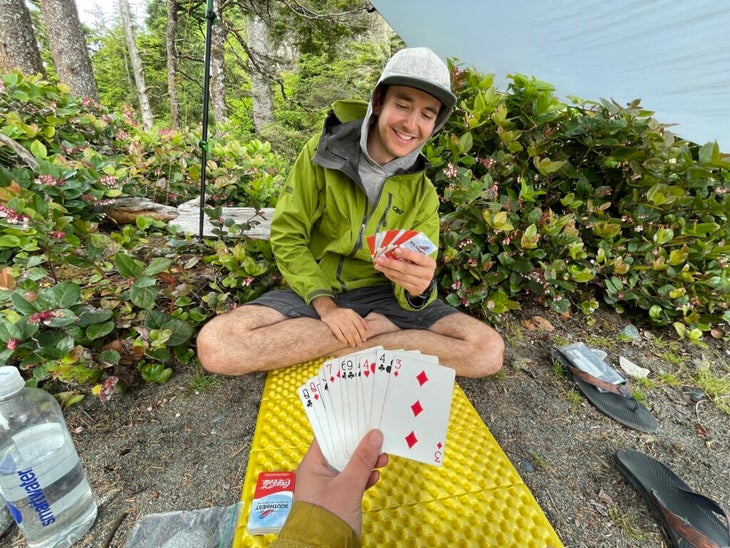This 16-Ounce Piece of Gear is the Most Versatile Item I Carry

On the fifth day of a recent backpacking trip in British Columbia, I trudged into camp completely drenched. My lightweight rain shell had soaked through hours ago, and the sleeves clung to my arms. Rainwater dripped off the ends of my braids and the brim of my hat. As soon as I stopped walking and dropped my pack, the shivers set in.
Even though it was summer, I knew hypothermia was a real threat. I needed to warm up fast, and that meant getting dry. If I set up my tent in this downpour, the inside would surely get wet. Luckily, I had another trick up my (very wet) sleeve.
Within minutes, my partner and I had rigged a tarp over our campsite. Without having to pitch and crawl into our tent, I could stand up, shed my wet layers, and change into dry clothes. Then, I fired up the stove to make some hot chocolate to warm my shaking hands, gobbled down some snacks, and rigged a clothesline to hang our soaked garments. All this while taking in the view from our oceanside camp. Eventually, the rain broke for long enough to set up the tent.
Many of my backpacking friends eschew carrying a tarp in addition to a tent, citing the extra weight. But in my professional opinion, those meager ounces are almost always worth it.
Similar Reads
In addition to providing shelter in poor weather, a tarp has nearly limitless applications. And with a plethora of ultralight and compact models on the market, you can reap the benefits while adding negligible weight to your kit. Here are some of my favorite uses.

Rig Up a Living Room
Sure, your tent keeps you protected from the elements, but it’s often not a great place to cook, eat, dry your gear, or hang out as a group. A tarp offers a space to gather, stretch out, play cards, and snack without worrying about getting crumbs in your sleeping space. On my recent trip, we watched whales breach just offshore and chatted with other hikers while staying sheltered from the rain. Let’s see an enclosed tent do that. No rain forecasted for your hike? A tarp can also provide a shady hangout in desert or alpine landscapes.
Stay Dry
In serious downpours, I like to rig a tarp over my tent, so I can pitch and take it down without soaking my shelter. I’ve even carried a small, lightweight tarp on day trips. Last winter, my partner and I pitched a cozy shelter over our ski poles and enjoyed a picnic lunch in a driving snowstorm. There’s nothing like being dry and comfortable as you watch a storm rage around you.
Survive in an Emergency
A tarp can be a useful tool in the event of a serious injury or illness. You can use it to improvise a litter to carry a hurt person, a sled in snowy conditions, or wrap someone who is experiencing hypothermia. In survival situations, you can use a tarp to carry heavy loads, construct a solar still, fashion an improvised poncho, or if you’re feeling ambitious, build a boat like that guy on Alone. The possibilities are endless.
Have a Yard Sale
Need to find a piece of gear that’s buried in the bottom of your pack? Want to take a snack inventory midway through a long trip? Sure, you can dump all of your gear in the dirt, or try and balance it all on a flat-ish rock. But with a tarp, you can lay out all of your clothes, food, and equipment without picking up a speck of dust. Having a clean, dry place for a gear-splosion is an underrated benefit of carrying a tarp.
Backup Shelter
On a recent trip, I experienced such strong winds that my tent poles tore a large gash right through my rain fly. Unfortunately, I hadn’t packed my tarp, but I would have appreciated the insurance policy. If your tent fails or needs reinforcements, your tarp can pinch-hit.


